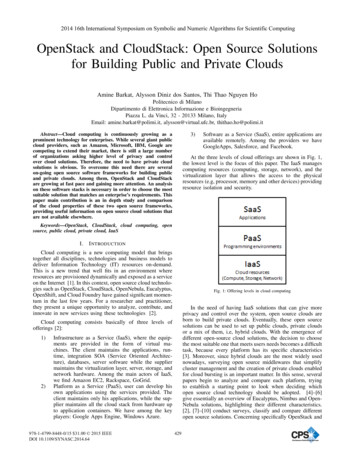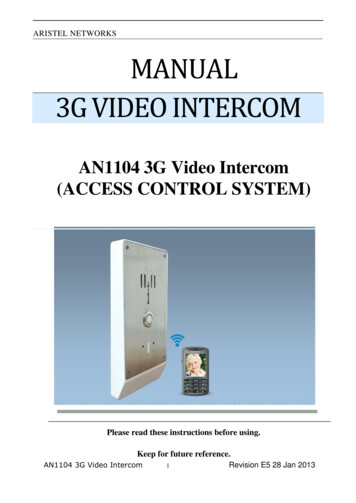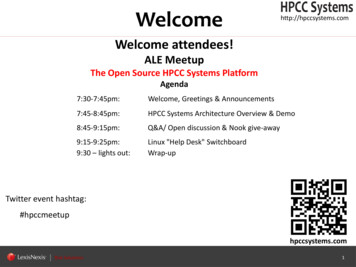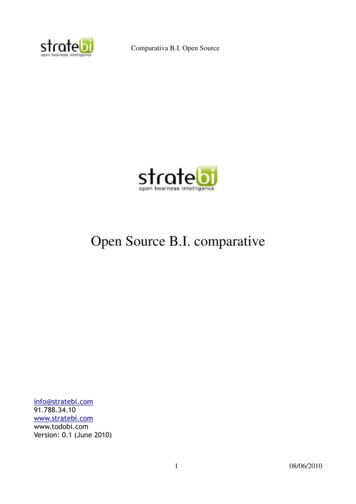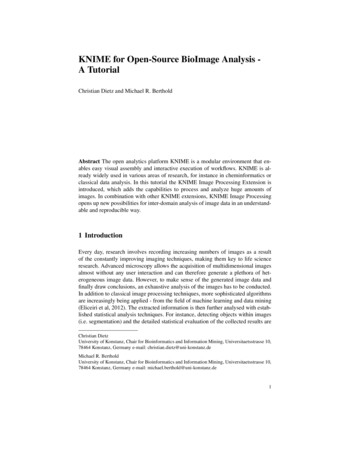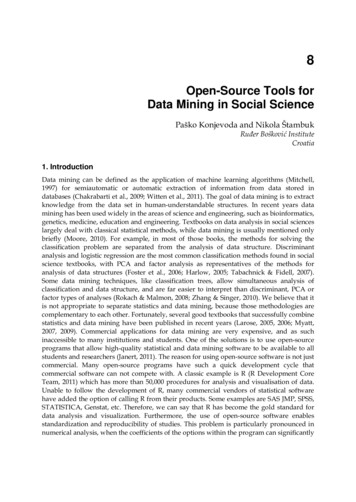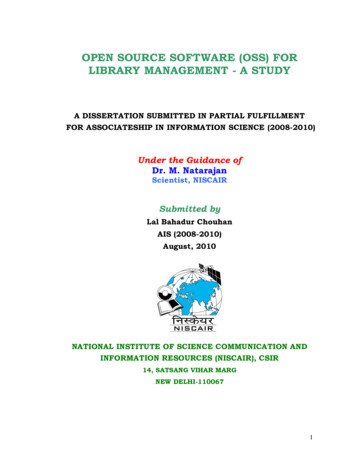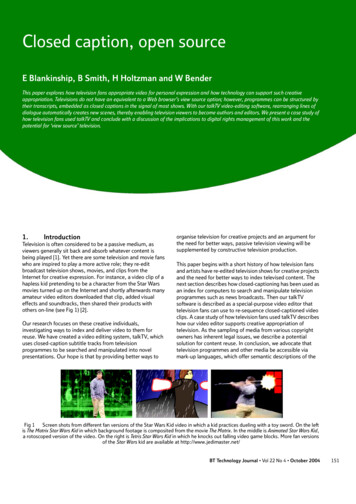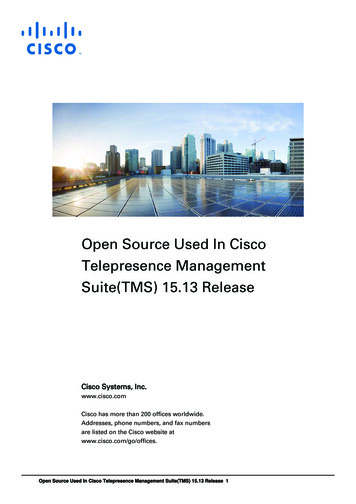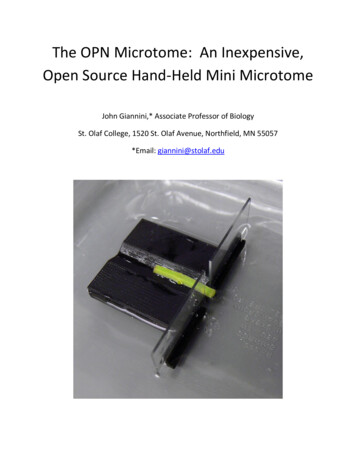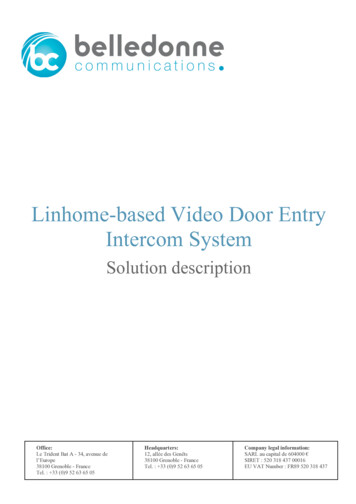
Transcription
Linhome-based Video Door EntryIntercom SystemSolution descriptionOffice:Le Trident Bat A - 34, avenue del’Europe38100 Grenoble - FranceTel. : 33 (0)9 52 63 65 05Headquarters:12, allée des Genêts38100 Grenoble - FranceTel. : 33 (0)9 52 63 65 05Company legal information:SARL au capital de 604000 SIRET : 520 318 437 00016EU VAT Number : FR89 520 318 437
IntroDigital video door entry intercom systems combined with mobile devices can highly leverage onregular SIP VoIP technology to bring a new set of services to end-users: get notified when a visitorpresses the ring button, see him with video, interact with him with voice and video - at home as well asanywhere else under Wi-Fi or with mobile network coverage. This document describes how bothLinhome, liblinphone sdk and Flexisip can be used together to build a SIP network dedicated to homeautomation and surveillance.IndexINTRO1INDEX1SOLUTION ARCHITECTURE2In house integration2Extension to smartphones connected to the public internet3SOLUTION COMPONENTS4Mobile appTypical use cases:Application detailsCompatibility with entry doorbell4466Entry video phoneTypical use cases:66In-house control panelTypical use cases:88SIP proxy on the public internetTypical use mmunications.com - www.linhome.org1
Solution architectureIn house integrationDigital video door entry intercom systems aim to bring audio and video from an entry phone to both anin house control panel and any mobile device that is connected either via a local network or the publicinternet, using regular SIP (rfc3261) & RTP (rfc3550).This drawing shows a typical residential deployment where liblinphone Voice and Video SDK can beused both for mobile apps, embedded in entry video phones and into in-house control panel. This multidevices deployment requires to use a SIP Proxy server to route SIP video calls from the entry videophone to both the in-house control panel and mobile apps. This call routing function can easily be handledby Flexisip, the open source SIP proxy server written by the Belledonne Communications, the companydeveloping both Linphone and Linhome apps.Mobile apps also have the ability to establish a SIP call to an entry door phone in order to monitor videocamera at any time.sales@belledonne-communications.com - www.linhome.org2
Extension to smartphones connected to the public internetA common use case is to extend the display of the video coming from an entry phone to multipledevices, including smartphones connected to the public internet.The above diagram shows a use case where a Flexisip SIP proxy server is deployed in the cloud to serveas audio/video broker, between smartphones connected from the public internet, and an entry videophone connected to the in-house Flexisip SIP proxy server that is embedded in a control panel.sales@belledonne-communications.com - www.linhome.org3
Solution componentsMobile app Mobile apps have been developed to meet the needs for end-users to both control and monitor audioand video doorbells from their smartphone or tablet/iPad.Main features are:The ability to be notified of someone ringing at the door, with video preview if available. It includesthe ability to start an audio call to communicate with the visitor.Outgoing calls to preconfigured sip-based doorbells or video cameras.Action buttons to switch on the light, or any possible doorbell’s action to be remotely controlled.Call history with recording of audio/video streams coming from the doorbell.Easy QR-code based remote configuration.Typical use cases:Scenario 1: Answering a call coming from a video door phoneWhen someone is ringing the doorbell of an entry video phone, it initiates an incoming SIP call withvideo preview, which awakes the app if it is running in the background, using Apple’s and Google’sVoIP push notifications (figure 1&2).Figure 1 - Linhome incoming call view(the Linhome app was running in the foreground)Figure 2 - Linhome push notification view (iOS)(the Linhome app was running in the background)sales@belledonne-communications.com - www.linhome.org4
The smartphone’s user can accept the incoming call (figure 3&4). If the user accepts the call, then hecan make different actions like opening the door, turning on the microphone, switching on the light,hanging up, etc. (action buttons are customizable)Figure 3 Linhome 2-ways Audio communicationFigure 4 – Linhome Video communicationScenario 2 : Checking the video camera of the doorbellAt any time, a user has the ability to reach his house’s entry door phones. When launching the app, thelist of configured doors is displayed. Pressing on a row establishes a regular SIP call to this entry doorphone:Figure 5 – Linhome list of home’s devicessales@belledonne-communications.com - www.linhome.org5
Application detailsBelledonne communications develops and distributes Linhome, a full-featured highly customizablemobile application designed for intercom use cases. Written in Swift/Kotlin, it’s available on both IOSand Android.Linhome is always reachable thanks to its implementation of Push Notification for SIP (rfc8599).Linhome offers a built-in integration with a Flexisip sip proxy backend. It can also be used with anythird party SIP server. For reference, visit our Linhome’s web site at www.linhome.org.Linhome leverages the liblinphone’s VOIP SDK. For reference, got to: tibility with intercom hardware products Linhome is compatible with any SIP-based entry door phone. Main supported standards are:SIP, for session establishmentEarly media, for video previewH264/G711, as primary audio/video codecsRTP secured/unsecured with or without AVPF extensionEntry video phoneEntry video phones are typically embedded devices with both a camera and a microphone, runningLinux. Purpose of this equipment is to initiate a video call when a visitor presses the ring button. Thisvideo call is started with a one-way early-media video stream and/or a two-ways audio stream sent bythe entry door phone. Thanks to this early-media video stream, it is possible to view who is in front ofthe door during the ringing state. A receiver application, running either on a mobile app or on an inhouse control panel, can decide to accept the call and enter in a duplex audio/video session, or just tounlock the door.Typical use cases:Scenario 1: Answering a call coming from a video entry phoneSIP call flowThis use case corresponds to the following SIP call flow:sales@belledonne-communications.com - www.linhome.org6
When a visitor presses the entry video phone’s ring button, a SIP INVITE is sent to the in-house SIPproxy. This SIP proxy, that may eventually be located inside the in-house control panel, then forks thisINVITE to all currently registered devices, in this case a mobile device (a tablet or a smartphone) andthe in-house monitor. Both the mobile app and the in-house monitor start ringing and answering a 183 SIP response with anSDP indicating a receive-only media direction. These 183 messages are modified by the in-house SIPproxy to insert a media relay into the media path. Purpose of this media relay is to fork media streamscoming from the entry video phone to all ringing devices. Upon reception of first 183, the entry phone starts sending video to the SIP proxy that relays media tothe mobile device. When the SIP proxy receives the second 183 from the monitor, it starts forking media streams comingfrom the entry phone to the in-house monitor. Note this second 183 does not have any impact on theentry phone. Later, someone in the house may decide to take the call from the in-house monitor. This action triggersa 200 ok, which is sent to accept the call in full duplex mode. Upon receival of this 200 ok, the in-house SIP proxy cancels all the call branches that are still inringing state.Application developmentLiblinphone VOIP SDK is available in C, C and Python, which are languages particularly suitablefor embedded systems. For reference documentation, visit linphone web site.Hardware integrationLiblinphone VOIP SDK leverages linux for both audio and video capture and rendering. On Linux,liblinphone’s built-in interfaces are: v4l2 for video capture X11 Xv or OpenGL for video displaysales@belledonne-communications.com - www.linhome.org7
Alsa, Pulse audio and OSS for audio capture/playback Software echo cancelerThanks to a plugin API, Liblinphone’s media processing engine, called Mediastreamer2, can easily beextended to interface with hardware based video encoder or echo canceler. For referencedocumentation, go to Mediastreamer2 API documentation.Software packagingA BitBake based distribution is planned to specifically address embedded systems, such as YoctoLinux. Alternatively, regular rpms can also be used.In-house control panelIn-house control panels are very often the brain of an entry door system. They are the perfect place forthe in-house SIP Proxy to seat. The purpose of this SIP proxy is to route incoming calls arriving from entry phones to all appliances inthe house, namely mobile apps and in-house monitors. The main functions of the in-house SIP are thefollowing:Registrar, as defined by rfc3261, to be able to reach mobile apps.User authentication, to make sure that only authorized mobile apps can receive incoming calls from theentry phones.Call forking, to distribute incoming calls to all connected devices.Media relay forking, to replicate media streams sent by the entry phones to all ringing devices.Portability on embedded devices, including ARM based devices.Ability to associate a single sip address to all users who are registered to the same sip domain (for groupcalling).Additionally, control panels with video display can also be based on liblinphone VOIP sdk. This case issimilar to Entry video phone.Typical use cases:Scenario : a call coming from a video entry phone is displayed on both an in-house monitor anda mobile app.SIP call flowThis use case corresponds to the following SIP call flow:sales@belledonne-communications.com - www.linhome.org8
Once connected to the local Wi-Fi network, a SIP REGISTER for a given domain is sent from the mobileapp to the in-house SIP proxy. This REGISTER is challenged. The mobile app initiates a subsequent REGISTER with authorization info, which are checked by the inhouse SIP proxy. The same process is repeated every time a new appliance connects to the home network. When someone presses the doorbell, an INVITE message with a broadcast sip uri is received by the inhouse SIP proxy. This INVITE is forked to all users registered to this SIP domain.Flexisip, the open source SIP proxy server that is written by the Linhome team, was developed with theseuse cases in mind.Software descriptionFlexisip can be compiled and deployed on any Linux based distribution, both ARM and x86. Currentlyboth deb and rpm packages are available. A BitBake based distribution is planned to specifically addressembedded system, such as Yocto Linux.AdministrationFlexisip is packaged as a Linux service with start/stop functions. Debug traces are logged into syslog.Configuration take place in a file in /etc/flexisip. For administration details, refer to the ons.com - www.linhome.org9
SIP proxy on the public internet An IP-based door entry intercom system shall always be able to reachmobile apps, even if the mobile devices on which the app is running arenot connected to the in-house local network. This function is implementedby a SIP proxy server deployed in the cloud (the “cloud SIP proxy”), thatcan be reached from a mobile device connected to the public internet. Thiscloud SIP proxy server shares its specification with the in-house proxy,but with addition of specific features, as listed below:Secure connection based on SIP-TLS and SRTP.Push notification integration, to maximize smartphone reachability.Scalability/high availability, to be a central point for all subscribers.Multi SIP domain management grouping users by houses.Management of in-house SIP proxy connections, for interconnection home network.Typical use cases:Scenario : A all coming from a video entry phone is displayed on both an entry video phone anda mobile app via the public internet.SIP call flow A mobile device that is connected to the public internet – either over 3G/4G or public WI-FI – registersto the cloud SIP proxy using a secure connection, under the SIP domain of their home network. When a visitor rings the bell button, a SIP INVITE is sent to the in-house SIP proxy. This SIP INVITEis forwarded to both local users registered in the house and to the cloud SIP proxy. The cloud SIP proxy transfers the received INVITE to all registered users for a given home’s SIP domain.sales@belledonne-communications.com - www.linhome.org10
The video RTP stream sent from the entry video phone is forked by the in-house SIP proxy to both usershaving answered 183 responses in house, and to the cloud SIP proxy if a 183 was received from outside. The cloud SIP proxy forks the video RTP stream to all users having answered 183.ConclusionThis document demonstrated relevance of adapting a voice and video over IP architecture to digitalintercom systems. Linhome, liblinphone SDK and Flexisip is the perfect couple to addresscommunications needs for both in and outside of house. Belledonne Communications is able to adaptthis reference architecture to customer’s specifics needs.ContactWorldwide edonne CommunicationsLe Trident Bat A - 34 avenue de l'Europe38100 Grenoble - FRANCETel 33 (0)9 52 63 65 05Fax 33 (0)9 57 63 65 05sales@belledonne-communications.com - www.linhome.org11
Liblinphone VOIP SDK is available in C, C and Python, which are languages particularly suitable for embedded systems. For reference documentation, visit linphone web site. Hardware integration Liblinphone VOIP SDK leverages linux for both audio and video capture and re

